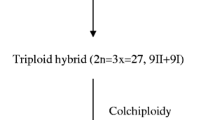Abstract
Morphological, reproductive and karyological variability were investigated in fifteen populations of Allium oleraceum transferred from natural populations in Lithuania to the field collection of medicinal and aromatic plants of the Institute of Botany of the Nature Research Centre in Vilnius. Nine populations were tetraploid (2n = 4x = 32), four pentaploid (2n = 5x = 40) and two consisted of both cytotypes. The greatest differences among the populations and between the ploidy levels were observed in stem height and mass of aerial bulbils per plant. The seed production was very low and did not differ significantly between the ploidy levels, while neither tetraploids nor pentaploids did produce any seed if insects were prevented from visiting their flowers. The means of the morphological characters were higher in pentaploids than in tetraploids. However, none of them provided the possibility of determining ploidy level without chromosome counting.
Similar content being viewed by others
References
Åström H. & Hæggström C.-A. 2003. Chromosome numbers of Allium scorodoprasum and A. vineale from SW Finland and W Ukraine. Ann. Bot. Fenn. 40: 1–3.
Åström H. & Hæggström C.-A. 2004. Generative reproduction in Allium oleraceum (Alliaceae). Ann. Bot. Fenn. 41: 1–14.
Chen G., Sun W.B. & Sun H. 2009. Morphological characteristics of leaf epidermis and size variation of leaf, flower and fruit in different ploidy levels in Buddleja macrostachya (Buddlejaceae). J. Syst. Evol. 47: 231–236.
Duchoslav M. 2001. Allium oleraceum and A. vineale in the Czech Republic: distribution and habitat differentiation. Preslia 73: 173–184.
Duchoslav M., Šafřová L. & Krahulec F. 2010. Complex distribution patterns, ecology and coexistence of ploidy levels of Allium oleraceum (Alliaceae) in the Czech Republic. Ann. Bot., London 105: 719–735.
Hæggström C.-A. & Åström H. 2005. Allium oleraceum (Alliaceae) in Finland: distribution, habitats and accompanying vascular plant species. Memoranda Societatis pro Fauna et Flora Fennica 81: 1–18.
Inoue K., Katob T., Nobukunib A., Kunitakeb H. & Yabuyab T. 2006. Characterization of tetraploid plants regenerated via protoplast culture of Iris fulva and their crossability with Japanese irises. Scientia Hortic. 110: 334–339.
Karpavičienė B. 2002. Allium oleraceum populations: ecological attachment and reproduction. Botanica Lithuanica 8: 103–110.
Karpavičienė B. 2007. Chromosome numbers of Allium from Lithuania. Ann. Bot. Fenn. 44: 345–352.
Karpavičienė B. 2008. The distribution pattern of Allium oleraceum in Lithuania. Botanica Lithuanica 14: 105–111.
Krahulcová A. 2003. Chromosome numbers in selected monocotyledons (Czech Republic, Hungary, and Slovakia). Preslia 75: 97–113.
Lanke F., Shichang W., Zhenguo L., Nijs I., Keping M., Zhenqing L. 2010. Effects of resource availability on the trade-off between seed and vegetative reproduction. J. Plant Ecol. 3: 251–258.
Murin A. & Ferakova V. 1988. Karyological variability of the species Allium scorodoprasum L. Acta Fac. Rer. Natur. Univ. Comen., Botanica 36: 65–77.
Oba S., Fujimura Y. & Horiuchi T. 2004. Association of Grain Shedding Habit with Polyploidy in Tartary Buckwheat (Fagopyrum tataricum) Strains. Plant Product. Sci. 7(2): 212–216.
Oliveira V.M., Forni-Martins E.R., Magalhăães P.M. & Alves M.N. 2004. Chromosomal and morphological studies of diploid and polyploid cytotypes of Stevia rebaudiana (Bertoni) Bertoni (Eupatorieae, Asteraceae). Genet. Mol. Biol.27: 215–222.
Schnittler M., Pfeiffer T., Harter D. & Hamann A. 2009. Bulbils contra seeds: reproductive investment in two species of Gagea (Liliaceae). Plant Syst. Evol. 279(1–4): 29–40.
Stearn W.T. 1980. Allium L., pp. 49–69 In: Tutin T.G., Heywood V.H., Burges N.A., Moore D.M., Valentine D.H., Walters S.M. & Webb D.A. (eds), Flora Europaea 5. Cambridge University Press.
Šafřová L. & Duchoslav M. 2010. Cytotype distribution in mixed populations of polyploid Allium oleraceum measured at a microgeographic scale. Preslia 82: 107–126.
Wetschnig W. 1992. Chromosomenzahlen Kärntner Gefässpflanzen (Teil 3): Karyologie und Verbreitung der Allium-Arten (Alliaceae) in Kärnten. Carinthia II. 182: 497–533.
Author information
Authors and Affiliations
Corresponding author
Rights and permissions
About this article
Cite this article
Karpavičienė, B. Morphological, reproductive and karyological variability in Allium oleraceum in Lithuania. Biologia 67, 278–283 (2012). https://doi.org/10.2478/s11756-012-0003-3
Received:
Accepted:
Published:
Issue Date:
DOI: https://doi.org/10.2478/s11756-012-0003-3




